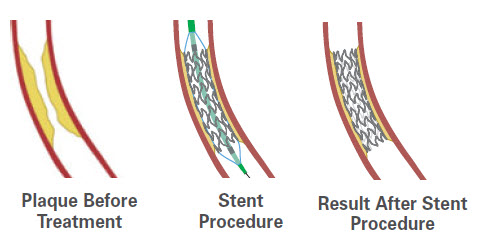
Discover how Boston Scientific’s coronary stents work to widen clogged arteries and help treat coronary artery disease (CAD).
What is coronary artery disease?
CAD happens when a waxy substance called plaque builds up on the inner walls of your coronary arteries. This causes your arteries to harden and narrow, decreasing blood flow to your heart. As a result, your heart doesn’t get the blood, oxygen and nutrients it needs, which can lead to chest pain or a heart attack. CAD often develops over decades. So, you may not know you have a problem until you have a significant blockage or a heart attack.
How coronary stents work
Coronary stents are small, wire, mesh tubes that help widen a clogged artery and restore adequate blood flow to the heart. During the procedure, your cardiologist will place the stent over a thin, long tube with a balloon tip called a catheter and insert it into an artery in your groin or arm. Once the stent reaches the clogged artery, your doctor will inflate the balloon to expand the stent. When the stent reaches the desired size to widen the clogged artery, your doctor will deflate and remove the balloon.
The stent will stay in place permanently to help prop open the artery and decrease its chance of narrowing again. Over time, the inner lining of the artery will grow over the surface of the stent, making it a permanent part of your artery.

Types of coronary stents
Bare-metal stents
Bare-metal stents are tiny wire mesh tubes that help widen a clogged artery, but are not coated with a polymer or drugs to help prevent re-blockage of the artery. This type of stent may be used in patients who are allergic to either the polymer or drugs used in drug-eluting stents.
Drug-eluting stents
A drug-eluting stent is a bare-metal stent that has been coated with a polymer that gradually releases a drug over the time when re-blockage is most likely to happen. This helps reduce the chance of the artery becoming blocked again. There are two types of drug-eluting stents:
- Permanent Polymer Drug-Eluting Stent. In this type of stent, the polymer stays on the stent permanently, even after all the drug has been released.
- Bioabsorbable Polymer Drug-Eluting Stent. With this type of stent, the polymer and drug coating are fully absorbed by the body shortly after the drug has been fully released. This promotes better healing by eliminating long-term polymer exposure.
Coronary stent risks
Like all medical procedures, getting a coronary stent comes with some risks. Refer to the patient manual for your stent below to find the risks associated with your device. And be sure to talk with your doctor so that you thoroughly understand all the risks and benefits associated with the implantation of a coronary stent.